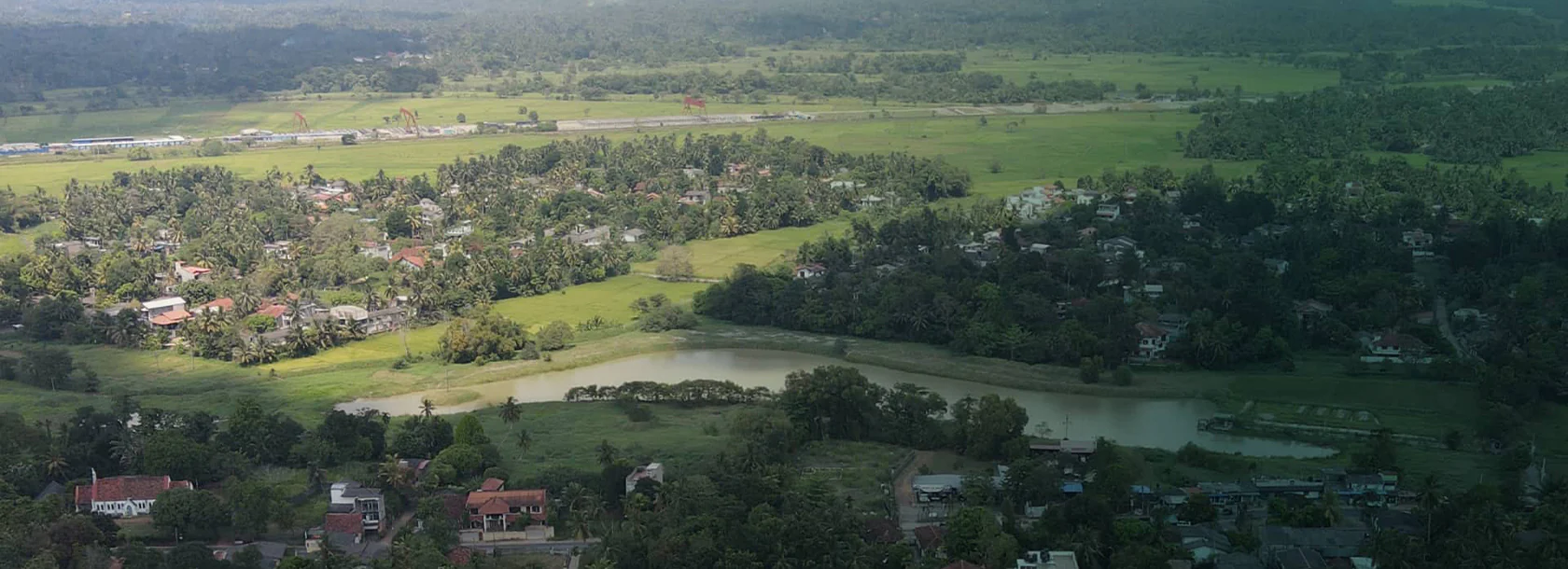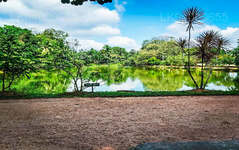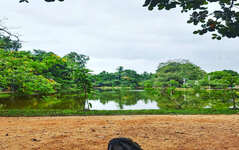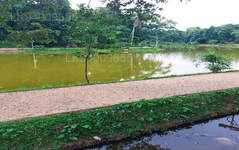
Gampaha City
Gampaha: Urban city in Sri Lanka with a mix of modern amenities and cultural heritage, including historic temples, bustling markets, and scenic landscapes.
Udugampola
Udugampola is a small town in Gampaha. It was a a subdivision of the Kotte Kingdom in the 15th century AD, and was ruled by the viceroy Sakalakala Wallabha; As such there are some interesting historical attractions in this town; mainly the Palace Mound, Pathaha Pond and the Uththararama Purana Temple. The Gampaha Botanical Gardens are also located in this vicinity.
The Palace MoundAccording to the ancient Sri Lankan royal chronicle, Rajaveliya, Udugampola was ruled by the provincial king or viceroy Sakalakala Wallabha, who was one of the three sons of King Veera Parakramabahu VIII of Kotte. His eldest brother King Parakramabahu IX ruled Kotte, while the third son King Thaniya Wallabha took over the Madampe area. King Sakakala Wallabha’s palace in Udugampola is believed to have been located at what is today known as Maliga Godella (Palace Mound). The existence of this palace in Udugampola has been confirmed due to an old engraved copper plate, named Kadirana Sannasa, which was discovered in Kadirana cinnamon plantation near Negombo town. While bearing no date, the Sannasa describes a grant made by King Vijayabahu of Udugampola. It states that a donation was made to a Brahmin by the king, at a royal assembly held in his new palace at Udugampola, on Poson Day (18 June 1517) when a full solar eclipse was sighted.
Pathaha PondPathaha Pokuna (pond) is an old bathing tank or pool located approximately half a kilometer from the Udugampola Roundabout, close to the Uththararama Purana Temple. As of 8 July 2005 the pond was formally recognised by the Government as an Archaeological Protected monument of Sri Lanka. It was identified as the bathing pool of the former king, and this pond has a story to tell.
King Sakalakala Wallabha was a brilliant warrior in the Kotta era. As a result, his kingdom flourished, and taking over his throne and rule was much longed for dream his sons. Due to that, two of his seven sons, the princes Kalu Kumara Bandara and Veeramunda conspired to murder their father and take his throne. They knew that the king would bathe here at the pond without fail, and since nobody else was allowed there was no chance of their evil plan being discovered. They planted pointed wooden stakes with metal tips in the pond so that they were hidden in the water, right at the spot where the king usually jumped into the pond using a flat stone.
However, on that fatal day moments before jumping onto the points to his death, the king observed that small flying insects were able to land on the water surface without sinking. Upon further scrutiny, the king found that the insects were landing on the pointed ends of hidden stakes. Understanding the betrayal of his sons, the king ordered that the two of them were to be executed. Though Veeramunda was captured and executed; Kalu Kumara Bandara escaped to the region of Sri Pada Mountain. Not wishing to suffer the shame of execution and unable to shake off the soldiers sent to capture him; he later committed suicide by jumping off a cliff. It is a belief of the natives that he never attained peace and became an evil spirit named Kalu Kumaraya that haunts the region to this day.
Pathaha Pokuna as it is today is said to be one of the largest ancient bathing ponds found in Asia. This L-shaped pond has an area of 25,805 square feet. The walls of the pond are made of laterite rock with little protrusions jutting outwards from the bottom to the top. The laterite blocks used in the construction of the pond vary in size, but they are fitted together perfectly with no concrete or anything of that sort. While the south and the east banks of the pond are made of laterite blocks in a normal manner, no evidence for the use of extended 122m long portions of the northern bank has been found.
Uththararama Purana TempleUththararama Purana Temple (also known as Maligagodella Temple) is located at the Udugampola – Weediyawatta Junction not far from Pathaha Pokuna. This temple received its archaeological site designation on 7 July 2005.
This temple region appears to have been a special place for the old Udugampola kingdom as several ruins related to this time were found here. It is believed that the temple was later built on the palace mount, on the exact place the palace stood. The ruins here include the protective moat and the bathing pond. In addition, there are other regions nearby with royal connotations; such as ‘Kehelbaddara’ where the royal flag bearer lived, Veediyawatta being the promenade where the annual royal parade of King Sakalakala Wallabha took place, Dolaagatha being the place where a small stream-fed into the royal water garden, ‘Devalapola’, and Maabodala where the highest granaries of the king’s treasury stood. Interestingly enough, these names are still used to this day.
Gampaha Botanical GardensIn close proximity to Udugampola lie the Henarathgoda Botanical Garden botanical gardens of Gampaha. It was established by the British in 1876; the sole purpose of it being to conduct experiments on tropical economy plants such as Rubber and etc. The first rubber tree imported to Sri Lanka was planted in this garden, and it was the very first seedling of a Brazilian rubber tree ever planted in Asia.
As it is today the garden is composed of a large variety of plants and many of which are from every corner of the tropical world. Sprawling over an area of over 43 acres, the Gampaha gardens are situated next to the river, Attanagalu Oya, and surrounded by paddy fields and a secondary forest. It is separated into lots of interesting sections with eye-catching landscaping and hosts an extensive collection of palms, orchids and trees endemic to the country. The garden is also home to approximately 80 species of birds, including ten endemic species; 18 species of mammals, including the Sri Lankan flying squirrel; 12 species of butterflies; and 10 species of dragonflies. With the recent addition of boat rides on Attanagalu Oya, the place has become more popular amongst the younger generations.
About Gampaha District
Gampaha is an urban city in Sri Lanka and is the capital of the Gampaha District in Western Province, north of Colombo. Gampaha District is separated from Colombo mainly by the Kelani River. Gampaha town is about 4km from Miriswatta on Colombo-Kandy road. Gampaha is surrounded by Yakkala, Miriswatta, Weliweriya Udugampola and Ja-Ela towns.
The name "Gampaha" in Sinhala literally means Five Villages. The five villages are known to be Ihalagama, Pahalagama, Medagama, Pattiyagama and Aluthgama.
About Western Province
The Western Province is the most densely populated province of Sri Lanka. It is home to the legislative capital Sri Jayawardenapura as well to Colombo, the nation's administrative and business center. Western Province is divided into 3 main districts called Colombo (642 km²), Gampaha (1,386.6 km²) and Kalutara (1,606 km²) districts. As Sri Lanka's economic hub, all the major local and international corporations have their presence in the city and so do all the major designer and high street retailers, so be ready to indulge in some retail therapy in western province.
Having the highest population in the all the provinces, the almost all the premier educational institutions in the island are located in western province. Universities in the province include the University of Colombo, the University of Sri Jayewardenepura, University of Kelaniya, Open University, Sri Lanka, Buddhist and Pali University of Sri Lanka, General Sir John Kotelawala Defence University and University of Moratuwa .Western province has the largest amount of schools in the country, which includes National, Provincial, Private and International schools.
【Text by Lakpura™. Images by Google, copyright(s) reserved by original authors.】















